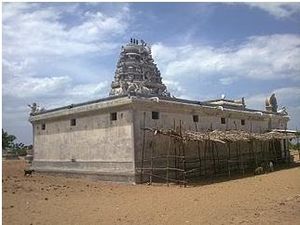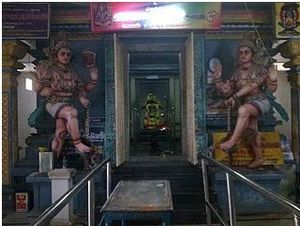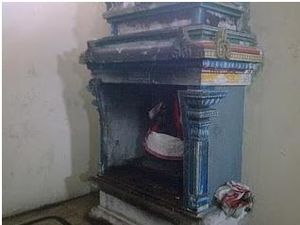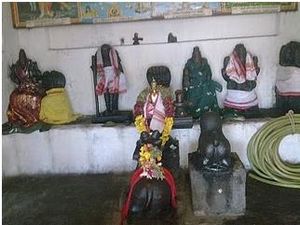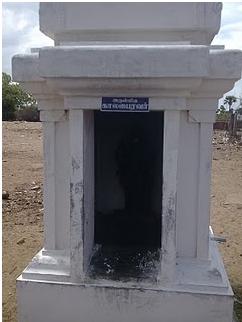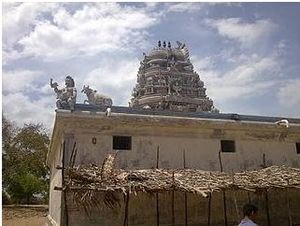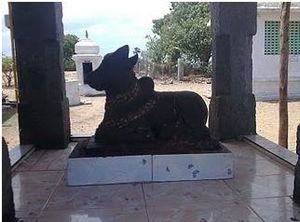Karungaali Sri Chinthaamaneesarar
Karungaali is a small village located in the north western side of Chennai. Karungaali has a beautiful temple dedicated to Lord Shiva called Sri Chinthaamaneeswarar, amidst scenic surroundings.
The speciality of this temple is that, it has sea in front, a river behind and forest on either sides. It is a very rare sight to see a temple amidst such a natural setting.
Lord Shiva has 5 faces;i.e. Isaanam, Thathpurusham, Vaamadhevam, Sathyojaatham and Agoram. There are 5 Shiva temples in and around Chennai, representing each of the 5 faces of the Lord. Out of those 5 this temple represents the Agora face of Lord Shiva the other 4 being Ramagiri Sri Vaaleeswarar (Isaanam), Suruttuppalli Sri Pallikondeeswarar (Thathpurusham), Aarani (near Periyapaalayam) Sri Sampangi Pichaaleeswarar (Vamadhevam) and Ariyathurai Sri Varamoortheeswarar (Sathyojaatham). Interestingly, all these 5 temples lie on the banks of Brahmaranya (Arani) river.Karungaali, where this temple is located, is where the Brahmaranya (Arani) river finally merges into the Bay of Bengal ocean.
As per legend, there lived a Rishi (Sage) by name Sattai Muni who performed Thapas (penance) in this place on the banks of Brahmaranya River. It is said that he enshrined the deity at this temple and worshipped Lord Shiva here. According to the inscriptions, the temple is over 1300 years old.
The temple is beautifully located with the river on one side and the sea on the other. The sanctum is small and there are no boundary walls to the temple. There are other shrines located outside the sanctum for other deities. The main deity Sri Chinthaamaneeswarar is so majestic and beautiful, facing east towards the sea.
A wonderful Nagaabharanam (coiled serpent) adds beauty to the Shiva Lingam. Dwarapaalakas (door keepers) are seen guarding outside the sanctum. Sri Nandhigeswarar is seen facing the Lord towards the sanctum.
Lord Ganesha (Vinayakar) and Sri Murugar are present on either sides of the sanctum with the names, Sri Chinthaamani Vinayagar and Sri Chinthaamani Murugar respectively.
There is a small shrine outside the sanctum where Ambaal Sri Sivakaamavalli is seen facing east. There is also a Simha Vaahana facing the Goddess. Adjacent to Ambaal, there is another small Shiva Lingam present with another Nandhi. There are also other deities like Sri Dhandaayudhapani (Murugar), Sri Mahavishnu, Sri Nagar and Sri Durgai next to each other, present in the same shrine.
On the north eastern side, outside the sanctum, there is a separate shrine for Sri Kaala Bhairavar. This temple is also considered a Bhairava Kshethram where people worship Lord Bhairavar for a sooner marriage and other wishes.
The Vimana above the sanctum is built in Gajabrishta shape to look like the back of a sleeping elephant which in Thamizh is called Thoonganai Maadam, a Chozha style of temple architecture. This temple is said to be built during the Chozha period.
This temple is considered equivalent to Kasi (Varanasi) and Rameshwaram as it lies both on the sea shore and the banks of a holy river. Performing annual rites to the ancestors during Amavasya (new moon) and Pournami (Full Moon) days here is considered equal to that of performing them at Kasi or Rameswaram. Many people visit here to do the annual rites to their ancestors.It is also believed that the Lord grant their wishes who worship Him here and stay overnight during Pournami days.
Sri Chinthaamaneeswarar is the Kuladheivam (clan God) for the fishermen in this village. Also the people of this village worship the Lord here by preparing Pongal at the temple, like how it is done in Amman temple in villages. It is very rare and unusual to see this type of worship in Shiva temples.
Chithra Pournami (Full moon day in the Thamizh month of Chithirai) is very popular here in this temple. People from neighbouring villages and also from other places throng here in the night of Chithra Pournami, prepare Pongal and offer to the Lord and worship Sri Chinthaamaneeswarar here. It is said that the entire place will be filled with people and everyone will be staying overnight on the sands during that night to get their wishes fulfilled.
How to Reach Karungaali[edit]
To reach Karungaali one has to take the road from Minjur towards Pazhaverkadu (Pulicat). After travelling about 10 kms from Minjur one can reach a village named ‘Kaattoor’. one has to take a right turn from Kaattoor and drive about 5 km (bad and sandy road amidst many salt lakes) to reach the banks of the river Arani.
After reaching the river Arani, one has to take a boat to cross it and reach the temple situated in Karungaali village. There is only one boat available and sometimes we have to wait for some time for the boat man to arrive. He charges Rs. 10/- for an up and down trip which takes hardly 5 minutes for each way. Alternatively, to reach the temple by road one can also take the Ennore Port Road, which will also lead to this temple.
Karungaali is worth visiting for its picturesque location and uniqueness in spite of distance and bad roads. Temple contact : Sri Shanmugam (Temple Priest) - 98402 1413

